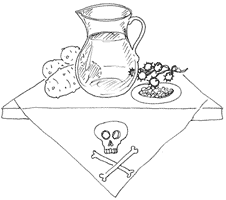Lethal larder: Eating yourself to death

DRAWING BY DEBORAH DERR McCLINTOCK
Q. Around the world, what food even when properly prepared has made more people sick than any other? –J. Child
A. Notice on TV's Survivor how many of the contestants gag or vomit after eating insects or eyeballs or drinking blood, while others just toss these down and smile, says University of California-Davis nutritionist Louis Grivetti.
So there are two types of food sickness: something culturally inappropriate, or something containing a pathogen or toxin that may make one ill. Mole dishes sold at the great plaza in downtown Mexico City are a delight to the senses, with their wonderful chocolate sauces (containing from 10-50 ingredients). But for many gringos, they spell instant "death." Food sitting too long on a hot summer day may be deadly for a very different reason.
"If I were to choose just one food, it would be common drinking water– worldwide some 40,000 children per day die of diarrhea-related diseases primarily from unsanitary water!" Grivettti says.
Biologist Grady W. Chism, III agrees about water, but for a food, he chooses potatoes. Exposed to sunlight, they produce solanine; properly stored they're no problem. Folklore says potatoes in open barrels on the sides of Conestoga wagons may have caused the deaths of more U.S. settlers than arrows and bullets. "Allergens are another, possibly causing headaches, rashes... and an estimated 150 deaths a year in the U.S. alone." Shellfish and fish, especially raw, just might be it, says Don Schaffner of Rutgers. "Sushi would be my guess."
Q. For people with Nyctophobia, Lygophobia, Achluophobia, Myctophobia or Scotophobia, what would likely be their least favorite time of day? –W. Rodman
A. Nighttime, since the terms mean "fear of the night," "fear of the dark," or "fear of being in a dark place," says University of Sussex psychologist Dr. Andy Field. Fear of the dark is probably more common in young children but rarely develops into a full-blown phobia, marked by persistent fear that is excessive or unreasonable. One saving feature is that– unlike developing a fear of snakes, for example– in the case of nighttime darkness, we all have many positive experiences from youth on up that provide a sort of immunity, from Halloween trick-or-treating to prom night to romancing under the stars.
Q. If a tornado rated at F-6 on the Fujita scale were heading your way, where should you seek cover?– L. F. Baum
A. A bomb shelter might be advisable! The Fujita tornado scale commonly goes from F0 to F5, with F-5 signifying winds 261-318 mph, dealing incredible damage, says Plymouth State University meteorology professor Lourdes Aviles. Strong frame houses would be lifted off foundations and destroyed, automobiles hurled skyward like missiles, pavement peeled off roadways. F-6 winds, scaled at 319-379 mph, are unlikely, maybe even impossible. Their area of damage would likely be unrecognizable in any case amid the surrounding rubble from F-5/F-4 winds. In fact, official estimates generally come after a tornado passes, based on apparent damage, since any regular wind-measuring instruments in the tornado's path would be destroyed.
But an Oklahoma twister a few years ago was Doppler-pegged right at 318 mph, so measuring an F-6 could be just a matter of time. Theoretically there can be winds over 450 mph from a super-hurricane, or "hypercane," says Aviles. Here the ocean surface temperature would need to be 120 degrees!
"This amount of warming could be achieved only by extreme global warming or the heat from a huge asteroid impact, itself probably causing global destruction," he says.
Q. Which two animals have life expectancies of about 70 years, select mates for life, provide collective care for their young, suffer death from heart disease, bury their dead and kill for love of drink? –Haji
A. People and pachyderms, answers Ronald K. Siegel in Intoxication: Life in Pursuit of Artificial Paradise. It's odd to think of elephants consuming alcohol, but they certainly will if given the opportunity, at times with a vengeance: In West Bengal, a herd of 150 bulled their way into an illegal still and gorged themselves on moonshine mash, then went on a drunken rampage across the countryside, trampling huts, demolishing buildings, ultimately killing five people and injuring a dozen. In his 1857 travels, missionary David Livingstone noted the passion with which certain African elephants ate fermented Borassus fruits, devouring all that had ripened and fallen and then shaking the trees for more. Trained elephants in shows, if given a "menu," prefer a 7 percent alcohol solution (avoiding lower or higher concentrations) and will down the equivalent of 35 cans of beer, says Siegel. This is enough to start many of them growling, flapping their ears (for cooling), swaying and leaning against their chains to keep upright.
Send Strange questions to brothers Bill and Rich at .